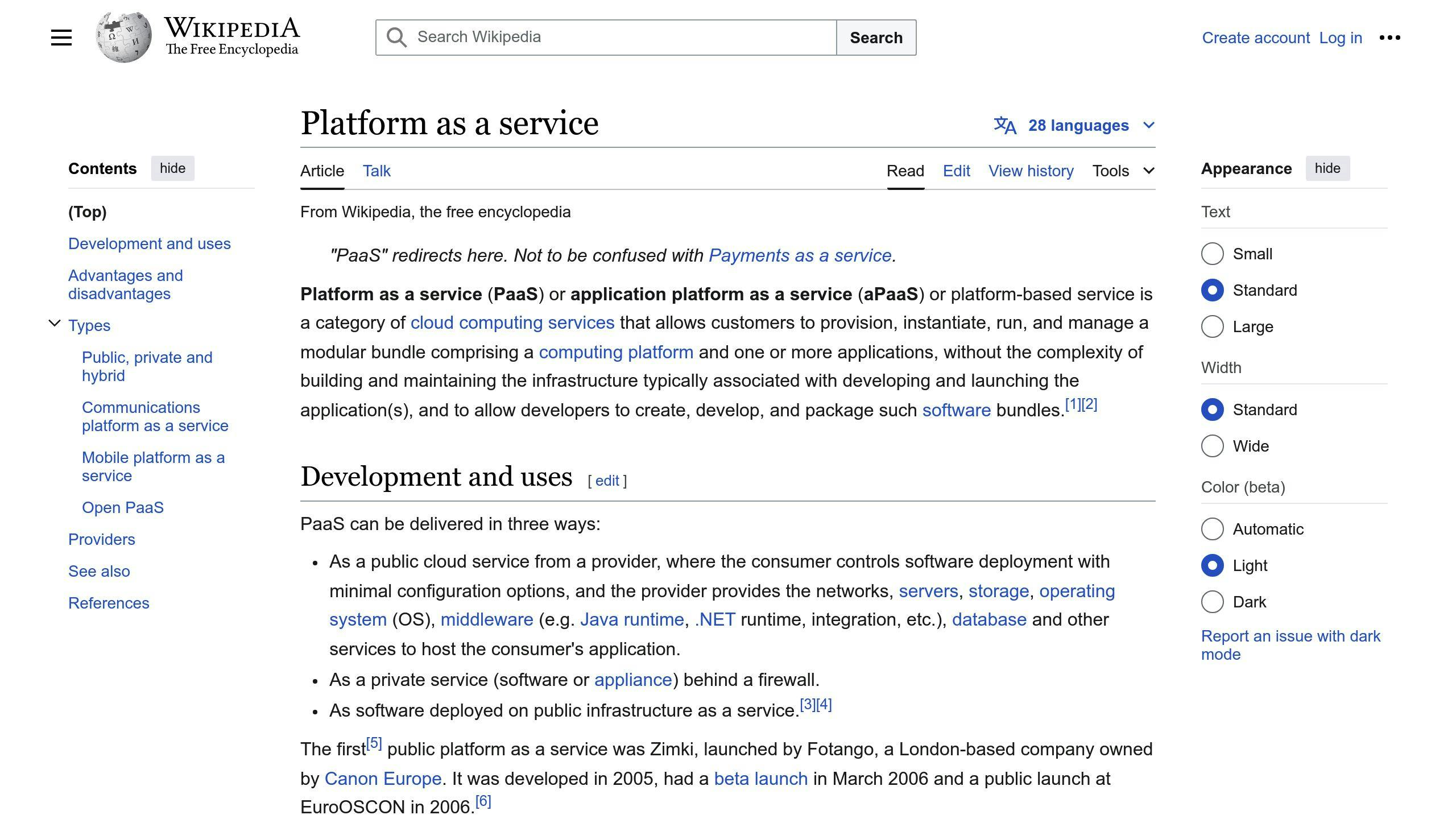SaaS and PaaS are cloud-based solutions that can help businesses improve efficiency and competitiveness. Here's a quick comparison:
| Feature | SaaS | PaaS |
|---|---|---|
| Offering | Ready-to-use software | Tools to build custom apps |
| Setup time | Quick | Longer |
| Customization | Limited | Extensive |
| Tech skills needed | Minimal | More advanced |
| Cost to start | Lower | Higher |
| Scalability | Easy to add users | Can build custom features |
| Control | Provider manages everything | You manage your apps |
Choose SaaS if you:
- Need a quick start
- Have limited tech skills
- Want lower upfront costs
Choose PaaS if you:
- Need custom solutions
- Have a strong tech team
- Want more control over your platform
Consider your business size, budget, tech expertise, and growth plans when deciding. SaaS works well for small businesses and startups, while PaaS suits larger companies or those with specific needs.
Related video from YouTube
What is SaaS (Software as a Service)?

SaaS is a way to use software over the internet. Instead of installing programs on your computer, you can access them through a web browser.
SaaS basics and features
SaaS offers ready-to-use software with these key points:
| Feature | Description |
|---|---|
| Easy access | Use from anywhere with internet |
| Lower costs | No need to buy software licenses |
| Grows with you | Add or remove users as needed |
| Always up-to-date | Provider handles updates |
| Data protection | Provider takes care of security |
SaaS in marketplace businesses
SaaS works well for marketplace businesses because:
- Quick to set up
- Needs little technical know-how
- Easy to connect with other tools
Pros and cons of SaaS for businesses
Here's a look at the good and not-so-good parts of SaaS:
| Pros | Cons |
|---|---|
| Easy to use | Limited changes allowed |
| Costs less to start | May not work well with other programs |
| Start using quickly | Depend on provider for help |
| Provider handles updates and security | Need to trust provider with data |
What is PaaS (Platform as a Service)?

PaaS is a cloud computing service that gives you tools to build, run, and manage apps over the internet.
PaaS basics and features
PaaS offers these key features:
| Feature | Description |
|---|---|
| Development tools | Provides tools for coding, testing, and launching apps |
| Hosting | Handles app hosting, including scaling and security |
| Middleware | Offers services like databases and user login systems |
| Database management | Helps with setting up and running databases |
PaaS in marketplace businesses
PaaS works well for marketplace businesses because it lets them:
- Build custom apps without needing lots of tech know-how
- Work together with developers more easily
- Grow their apps quickly as needed
Pros and cons of PaaS for businesses
Here's a look at the good and not-so-good parts of PaaS:
| Pros | Cons |
|---|---|
| Faster app development | Can be hard to set up |
| Can make custom apps | Needs some tech skills |
| Less work managing servers | Still need to update your apps |
| Can save money | Must trust provider with data |
PaaS can help businesses build and run apps more easily, but it also has some challenges to think about.
SaaS vs PaaS marketplaces: Key differences
How SaaS and PaaS work differently
SaaS and PaaS are two types of cloud services that work in different ways:
| Feature | SaaS | PaaS |
|---|---|---|
| What it offers | Ready-to-use software | Tools to build your own apps |
| Who manages it | Provider handles everything | You manage your apps |
| How much you can change | Limited changes | You can make big changes |
| What you need to know | Little tech knowledge needed | Some tech skills required |
Growth and change options
SaaS and PaaS have different ways to grow:
- SaaS: Easy to add more users, but hard to make big changes
- PaaS: Can build custom features, but may be harder to grow quickly
Cost breakdown
Here's how SaaS and PaaS costs compare:
| Cost Type | SaaS | PaaS |
|---|---|---|
| Starting costs | Low | Can be high |
| Monthly fees | Set price | Based on how much you use |
| Upkeep costs | Included | You may pay extra |
Building and changing your platform
SaaS and PaaS offer different ways to build and change:
- SaaS: Use what's given, make small tweaks
- PaaS: Build from scratch, make big changes
Safety and rules to follow
Both SaaS and PaaS have safety concerns:
- SaaS: Provider handles most safety issues
- PaaS: You're in charge of keeping your apps safe
When picking between SaaS and PaaS, think about what your business needs most: a ready-to-use tool or the freedom to build your own.
How to choose between SaaS and PaaS
Picking SaaS or PaaS depends on what your business needs, what you can afford, and what tech skills you have. Here's what to think about:
Company size and future plans
| Business Size | Best Option | Why |
|---|---|---|
| Small or startup | SaaS | Easier to use, costs less to start |
| Medium or large | PaaS | Can make custom apps, good for growth |
Tech skills and tools available
| Your Tech Skills | Best Option | Why |
|---|---|---|
| Limited IT knowledge | SaaS | Ready to use, needs less tech know-how |
| Strong tech team | PaaS | Can build custom apps, more control |
Money limits
| Budget Concern | SaaS | PaaS |
|---|---|---|
| Short-term costs | Lower | Higher |
| Long-term costs | May be higher | Can be lower |
| Payment style | Set monthly fee | Pay for what you use |
How fast you need to start
| Timeline | Best Option | Why |
|---|---|---|
| Need to start quickly | SaaS | Ready to use right away |
| Can take more time | PaaS | More time to build, but more custom |
Working with your current systems
Think about how SaaS or PaaS will work with the tools you already use. Ask yourself:
- Will it fit with what we have now?
- Do we need to change a lot to make it work?
- How much will those changes cost?
Pick the option that works best with your current setup and won't cost too much to put in place.
sbb-itb-8201525
When to use SaaS
SaaS works well for certain types of businesses. Here's when to choose SaaS:
Best times to pick SaaS
SaaS is good for:
- Small businesses or startups that need to start quickly
- Companies with little tech know-how
- Businesses that want to save money at the start
- Those who need to use software right away
Business types that fit SaaS best
| Business Type | Why SaaS Works Well |
|---|---|
| E-commerce | Can grow quickly as needed |
| Small to medium-sized businesses | Cheap and easy to use |
| Remote teams | Can use from anywhere |
| Companies with small IT teams | Don't need to manage software themselves |
SaaS helps these businesses focus on their main work instead of dealing with software issues.
When to use PaaS
PaaS works well for some businesses. Here's when to choose PaaS:
Best times to pick PaaS
PaaS is good for:
- Businesses that need to make their own apps
- Companies with tricky work processes
- Those who want more say in how their platform works
- Big companies that already have tech systems
Business types that fit PaaS best
| Business Type | Why PaaS Works Well |
|---|---|
| Big companies | Can make their own apps |
| Companies with complex work | Can control their platform more |
| Businesses with existing tech | Can use what they already have |
| New companies with special needs | Can grow and change easily |
PaaS helps these businesses grow and try new things. By using PaaS, they can focus on their main work while the provider takes care of the platform.
How to make your choice
When picking between SaaS and PaaS, think about what your business needs and wants to do. Here are some things to think about:
Key questions to ask
Before you decide, ask yourself:
| Question | Why it matters |
|---|---|
| What does my business want to do? | Make sure the platform helps you reach your goals |
| How much money can I spend? | Know the costs for each option |
| Do I have people who know about tech? | PaaS needs more tech skills than SaaS |
| How soon do I need to start? | SaaS is usually faster to set up |
| What are my plans for the future? | Pick a platform that can grow with you |
Think about your future plans
Pick a platform that will work for you now and later. Think about:
| Future need | What to consider |
|---|---|
| Changes to the platform | Will you need to make big changes later? |
| Business growth | Can the platform handle it if your business gets bigger? |
| Working with other tools | Will the platform work well with other things you might need? |
Wrap-up
Main differences recap
We've looked at SaaS and PaaS marketplaces. Here's a quick summary of their main differences:
| Feature | SaaS | PaaS |
|---|---|---|
| What it offers | Ready-to-use software | Tools to build apps |
| Setup time | Quick | Takes longer |
| Customization | Limited | More options |
| Tech skills needed | Few | More |
Picking what's right for your business
To choose between SaaS and PaaS, think about:
- What your business needs
- How big your company is
- What you want to do in the future
Ask yourself:
| Question | Why it matters |
|---|---|
| What does my business want to do? | Make sure the platform helps you |
| How much can I change things? | SaaS has limits, PaaS offers more freedom |
| How much money can I spend? | SaaS often costs less to start |
| Do I have tech-savvy people? | PaaS needs more tech know-how |
Take your time to look at both options. The best choice depends on what your business needs.
FAQs
What is the difference between PaaS and SaaS eCommerce?
SaaS and PaaS offer different ways to set up an eCommerce business:
| Feature | SaaS eCommerce | PaaS eCommerce |
|---|---|---|
| What you get | Ready-to-use online store software | Tools to build your own online store |
| Setup time | Quick to start | Takes longer to set up |
| Changes you can make | Few changes allowed | Many changes possible |
| Tech skills needed | Little to none | More tech knowledge required |
| Control over software | Limited | More control |
| Scaling | Easy to add more users | Can build custom features for growth |
SaaS is good for businesses that want to start selling quickly without much tech know-how. PaaS works well for companies that need a custom online store and have tech skills to build it.


